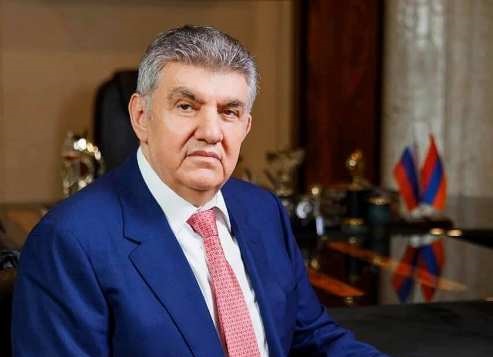
ARA ABRAMYAN PROVIDED THE UN AND UNESCO HISTORICAL DOCUMENTS CONFIRMING THE RIGHT OF ARMENIANS TO NAGORNO-KARABAKH
2024-02-03 17:29
Following Azerbaijan's September 2023
expulsion of more than 100,000 of the indigenous Armenian population from the
disputed enclave of the South Caucasus, the UN received documents confirming
that its predecessor, the League of Nations, had secured Armenian sovereignty
over Nagorno-Karabakh in 1921.
In 2008, the Institute of International
Law, with the support of businessman and philanthropist Ara Abramyan, Founder of
the Ararat Alliance Forum, published a multi-volume historical study
“Nagorno-Karabakh in International Law and World Politics: Documents and
Commentaries.” https://sarinfo.org/library_files/Барсегов-Юрий-Нагорный-Карабах-в-международном-праве-и-мировой-политике-Том-2.pdf
The study provides indisputable historical
evidence that Nagorno-Karabakh has not only been a primordially Armenian land
for thousands of years, but also reasonable confirmation that, from an
international legal point of view, it never belonged to Azerbaijan.
During the collapse of the USSR, the people
of the Nagorno-Karabakh Republic voted in a referendum in 1988 for their
independence, and for 30 years the NKR existed as a de facto independent,
although not recognized, state.
The modern Republic of Azerbaijan, during
the collapse of the USSR, in 1991 declared itself the legal successor not of
Soviet Azerbaijan, into which Vladimir Lenin included Nagorno-Karabakh, but of
the Azerbaijan Democratic Republic (ADR), created in 1918 and which existed for
less than two years.
There are documents in the UN archives
indicating that the Azerbaijan Democratic Republic was at one time denied
admission to the League of Nations precisely because it claimed illegal rights
to Karabakh, which, as part of the territory of Armenia, is mentioned in the
reference note of James Eric Drummond, Secretary General of the League of
Nations, March 1921.
It follows from it that the League of
Nations on the issue of the territorial affiliation of Karabakh considered this
region as a territory originally belonging to Armenia. Accordingly, following
the review of the Armenian-Azerbaijani territorial delimitation by the League
of Nations, it was confirmed that independent Azerbaijan has no rights to the
territory of Nagorno-Karabakh.
Ara Abramyan, a long-time UNESCO Goodwill
Ambassador since 2003, also drew the attention of the UN and UNESCO to the
critical threat looming over the cultural and historical heritage sites of
Nagorno-Karabakh. The enclave is a real open-air museum, thanks to more than
500 unique monuments of ancient and Christian culture located on its territory. (www.museumofthebible.org/location/ancient-faith-the-churches-of-nagorno-karabakh)
Azerbaijan announced plans to create a
working group to change the identity of these monuments - the so-called
“restoration of Albanian religious temples”, i.e. Albanization of Armenian
churches by erasing ancient Armenian inscriptions from them.
“This, in essence, is an act of state
vandalism, comparable in its cynicism to the Taliban’s shooting of the Bamiyan
Buddha statues in Afghanistan, and a civilizational challenge to all humanity
and international institutions, including the UN,” Abramyan emphasized. “This
is also a direct disregard for a number of international documents, including
the requirement issued by the International Court of Justice on December 7,
2021 for Azerbaijan to take the necessary measures to prevent all acts of
vandalism committed against the Armenian cultural heritage and to punish the
perpetrators.” (www.icj-cij.org/public/files/case-related/180/180-20211207-PRE-01-00-EN.pdf)
A clear illustration of how Baku deals with
the cultural heritage of the Armenian people after their expulsion from its
historical lands is the Nakhichevan Autonomous Republic, part of Azerbaijan,
where by 2007 the destruction of the cultural and historical trace was finally
completed and not only representatives of the Armenian people remained , which
made up 75 percent of the population, but also Armenian temples, museums,
necropolises and cemeteries. The same thing happened with 105
once-Armenian-populated villages, whose names were replaced with Azerbaijani
ones, and all traces of centuries-old Armenians living there were erased from
the face of the earth.
On January 4, 2024
the US State Department added Azerbaijan to the US List of Religious Freedom
Offenders, citing its treatment of Christians, Muslims, and ethnic Armenians
displaced from the Nagorno-Karabakh enclave. (www.rferl.org/a/religious-freedom-azerbaijan-belarus-united-states-re
... 61553.html)
“Considering that the issue of preserving the Armenian factor and world cultural heritage in Nagorno-Karabakh is not so much a matter of politics or geopolitics, but rather a universal human problem, a matter of a fair world order, preservation and transmission to future generations of the cultural code of humanity,” Abramyan wrote in his address to the Secretary General UN, “I request that a special UN conference be convened with the participation of historians and international law experts to consider the historical and legal right of Armenians to sovereignty in Nagorno-Karabakh, and to discuss mechanisms of international law to protect the cultural Christian heritage of Nagorno-Karabakh from the barbaric actions of the Baku r